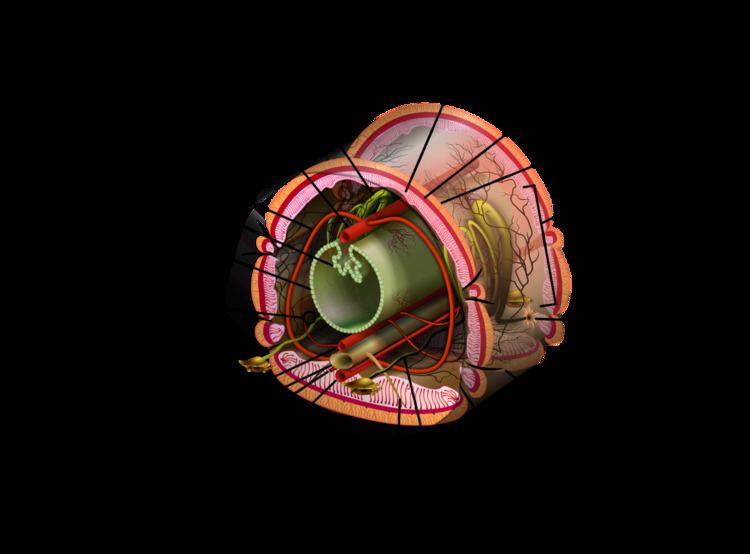 | ||
A body cavity is any fluid-filled space in a multicellular organism other than those of vessels (such as blood vessels and lymph vessels). The term usually refers to the space located between an animal’s outer covering (epidermis), and the outer lining of the gut cavity, where internal organs develop.
Contents
The human body cavity normally refers to the ventral body cavity, because it is by far the largest.
Coelom
A coelom is a cavity lined by an epithelium derived from mesoderm. Organs formed inside a coelom can freely move, grow, and develop independently of the body wall while fluid cushions and protects them from shocks.
Arthropods and most mollusks have a reduced (but still true) coelom, usually the pericardial cavity and the gonocoel. Their principal body cavity is the hemocoel or haeomocoel of an open circulatory system, often derived from the blastocoel.
Mammalian embryos develop two cavities: the intraembryonic coelom and the extraembryonic coelom (or chorionic cavity). The intraembryonic coelom is lined by somatic and splanchnic lateral plate mesoderm, while the extraembryonic coelom is lined by extraembryonic mesoderm. The intraembryonic coelom is the only cavity that persists in the mammal at term, which is why its name is often contracted to simply coelomic cavity. Subdividing the coelomic cavity into compartments, for example, the pericardial cavity / pericardium, where the heart develops, simplifies discussion of the anatomies of complex animals.
Organisms can be also classified according to the type of body cavity they possess.
Human body cavities
Anatomical structures are often described in terms of the cavity in which they reside. The body maintains its internal organization by means of membranes, sheaths, and other structures that separate compartments. The dorsal (posterior) cavity and the ventral (anterior) cavity are the largest body compartments. These cavities contain and protect delicate internal organs, and the ventral cavity allows for significant changes in the size and shape of the organs as they perform their functions. The lungs, heart, stomach, and intestines, for example, can expand and contract without distorting other tissues or disrupting the activity of nearby organs.
The ventral cavity includes the thoracic and abdominopelvic cavities and their subdivisions. The dorsal cavity includes the cranial and spinal cavities.
Together the cranial cavity and vertebral cavity can be referred to as the dorsal body cavity. In the posterior (dorsal) cavity, the cranial cavity houses the brain, and the spinal cavity (or vertebral cavity) encloses the spinal cord. Just as the brain and spinal cord make up a continuous, uninterrupted structure, the cranial and spinal cavities that house them are also continuous. The brain and spinal cord are protected by the bones of the skull and vertebral column and by cerebrospinal fluid, a colorless fluid produced by the brain, which cushions the brain and spinal cord within the posterior (dorsal) cavity.
The thoracic cavity consists of three cavities that fill the interior area of the chest.
The diaphragm divides the thoracic and the abdominal cavities. The abdominal cavity occupies the entire lower half of the trunk, anterior to the spine. Just under the abdominal cavity, anterior to the buttocks, is the pelvic cavity. The pelvic cavity is funnel shaped and is located inferior and anterior to the abdominal cavity. Together the abdominal and pelvic cavity can be referred to as the abdominopelvic cavity while the thoracic, abdominal, and pelvic cavities together can be referred to as the ventral body cavity. Subdivisions of the Posterior (Dorsal) and Anterior (Ventral) Cavities The anterior (ventral) cavity has two main subdivisions: the thoracic cavity and the abdominopelvic cavity. The thoracic cavity is the more superior subdivision of the anterior cavity, and it is enclosed by the rib cage. The thoracic cavity contains the lungs and the heart, which is located in the mediastinum. The diaphragm forms the floor of the thoracic cavity and separates it from the more inferior abdominopelvic cavity. The abdominopelvic cavity is the largest cavity in the body. Although no membrane physically divides the abdominopelvic cavity, it can be useful to distinguish between the abdominal cavity, the division that houses the digestive organs, and the pelvic cavity, the division that houses the organs of reproduction.
The cavities include:
